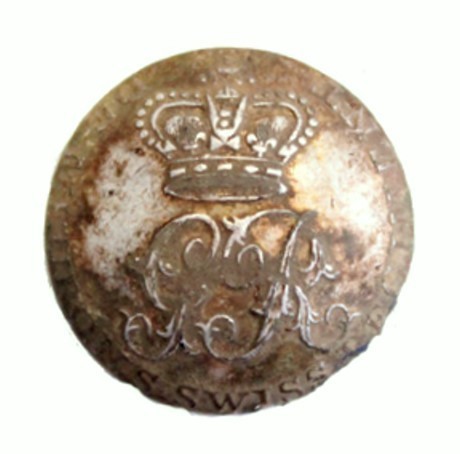A Brown Bess musket of the Napoleonic Wars stamped MSR: De Meuron's Swiss Regiment?

I came across the musket in these photos several years ago in Ontario, Canada, and since then have searched extensively for parallels for the unusual regimental markings on the barrel and buttplate tang. The musket is a flintlock 'India Pattern' of the Napoleonic Wars period, one of several million produced between 1793 and 1815 that saw service in British and colonial regiments around the world, including the War of 1812-14 between Britain and the United States.

The barrel-maker's name stamped beneath the barrel just forward of the breech.
The swan-neck cock dates the manufacture of the lock – or that component of it – to before 1809, when a more robust ring-neck cock was introduced. The underside of the barrel is stamped with the name Russel, one of a family based in Wednesbury near Birmingham who supplied barrels to the Board of Ordnance from 1793 and to the East India Company from 1807. What particularly interested me were the markings MSR. D. No. 9 stamped on the barrel in front of the breech and D No. 9 on the buttplate tang, as seen in the two images below (click to enlarge). The letters MSR would normally signify a regiment, and the letter D a company. I have seen only one parallel for this marking, on a musket sold by a dealer in the US with a Pattern 1809 cock and the barrel stamp M.S.R. F. No. 87., differing from mine only in the dies used and in the first three letters being separated by periods. The musket was apparently also stamped on the buttplate tang and on the ramrod (the ramrod was missing from my musket).


Having considered a wide range of possibilities for the period, including British, colonial British and US militia regiments, I've concluded that the most likely candidate for these markings is De Meuron’s Swiss Regiment, one of two Swiss regiments in the British army to serve in Canada during the War of 1812. The regiment is commonly referred to as ‘Régiment de Meuron’, but during its years in British service it was often styled in anglicised form - for example, a discharge certificate from 1816 that you can see here refers to ‘His Majesty’s De Meuron Regiment of Foot.’ An officers’ dress specification for its time in British service quoted in the most extensive modern history of the regiment, by Guy de Meuron, a descendant of the founder, notes that the belt and helmet plates were inscribed ‘De Meuron’s Swiss Regiment.', and exactly that wording appears a military button of the regiment recently found by a metal-detectorist in England. All of this suggests that MSR would have been an obvious abbreviation to stamp on muskets and other equipment and stores.

A button from England with 'De Meuron's Swiss Regiment' around the edge. For details of the find click here.
In a list of new arms received by British regiments serving in North America during the War of 1812 – the most recent complete rearming or the most recent significant issue – De Witt Bailey notes that De Meuron’s Regiment received 400 muskets and bayonets in May 1807, a date that might fit well with my musket. What makes an association with De Meuron’s Regiment even more compelling is the likelihood that the regiment’s muskets remained in Canada after the war. British regiments returning from colonial service commonly left their small arms in local Ordnance stores, something that would have made particular sense for a regiment that was disbanding. Before De Meuron’s Regiment left Lower Canada in 1816, some 343 officers and men accepted an offer to settle locally – many in the Perth area of eastern Ontario -with substantial land grants and a gratuity. They were encouraged to join the militia, and it seems reasonable to think that such men would have been allowed to keep their muskets. Some 88 veterans of the regiment, uniformed and provided with muskets, formed part of Lord Selkirk’s 1816 expedition to the Red River Colony in present-day Manitoba, seeing action in the ‘Pemmican War’ between the Hudson’s Bay and North-West Companies and a number of them settling there as well.
This attribution must of course remain guesswork until more evidence comes to light. I'd be very interested to hear from anyone who might have another of these muskets, or knows of further evidence that MSR may have been an abbreviation used by De Meuron’s Swiss Regiment during their period in British service.
For images and video of a Sea Service pistol of similar date, click here.

'Colonists on the Red River in North America', c. 1822, by Peter Rindisbacher, a young Swiss artist who was one of the original settlers under Lord Selkirk. The man with the military greatcoat and cap in the middle is thought to be a De Meuron Regiment veteran; the upper of the two long guns on the wall has the instantly recognisable butt shape of a Brown Bess musket. National Archives of Canada.
References
Bailey, De Witt. Small Arms of the British Forces in America 1664-1815. Mowbray Publishing, Woonsocket, 2009, p. 286.
Bailey, De Witt, and Nie, D.A., 1978, English Gunmakers. Arms and Armour Press (on the Russell family).
Goldstein, E and Mowbray, S. The Brown Bess. Mowbray Publishing, Woonsocket, 2010, p. 142-159.
Harding, David, Smallarms of the East India Company. Vol. 1, Procurement and Design. Foresight Books, London, 1997, Appendix C (Suppliers of Musket Parts), p. 316.
Lawson, C.C.P. and Severin, J.P. De Meuron’s Swiss Regiment, 1814-1816. Military Collector and Historian, Vol 9, issue 1 (1957), p. 77.
Meuron, Guy de. Le Régiment Meuron, 1781-1816. Le Forum Historique, Lausanne, 1982.



